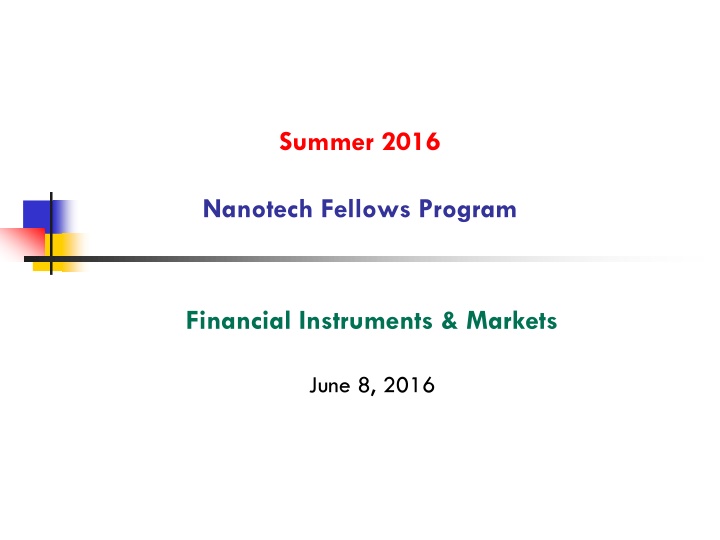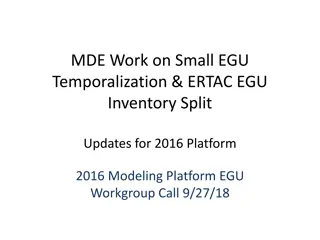
Financial Instruments and Markets in the Summer 2016 Nanotech Fellows Program
Explore financial instruments like bonds, common stocks, and private equity financing, along with the concept of efficient markets and the role of financial executives in marketing. Learn about financial markets, the distinction between money markets and capital markets, and the regulatory aspects of designing financial instruments. Dive into the world of securities and investor claims in this insightful overview of finance for engineers.
Download Presentation

Please find below an Image/Link to download the presentation.
The content on the website is provided AS IS for your information and personal use only. It may not be sold, licensed, or shared on other websites without obtaining consent from the author. If you encounter any issues during the download, it is possible that the publisher has removed the file from their server.
You are allowed to download the files provided on this website for personal or commercial use, subject to the condition that they are used lawfully. All files are the property of their respective owners.
The content on the website is provided AS IS for your information and personal use only. It may not be sold, licensed, or shared on other websites without obtaining consent from the author.
E N D
Presentation Transcript
Summer 2016 Nanotech Fellows Program Financial Instruments & Markets June 8, 2016
Todays Goals Bonds Call provisions; Covenants Rights to liquidation Bonds as an investment; Bond ratings Common Stocks as an investment Preferred Stocks Private Equity Financing Initial Public offerings Investment Banking Seasoned Issues What is an Efficient Market? Finance for Engineers
Financial Executive as Marketing Executive Financial executives need to raise money to finance the current operations and future growth of their companies To do so they must market the future cash flows of their firm Marketing entails the packaging of cash flows in order to fetch the highest price possible Customers receive a piece of paper stock certificate, bond, etc. on the nature of their claim on the firm s future cash flow Packaging cash flows involves security design Designing securities requires knowledge of different financial instruments this chapter focuses on (a) financial instruments, (b) the markets in which they trade Next chapter will focus on a company s choice of proper financing instrument Finance for Engineers
Financial Markets Financial markets describes the distribution system by which cash-deficit entities engage in transactions with cash-surplus entities Besides businesses, the entities in question include government agencies, universities, pension funds, endowments, individuals, commercial banks, insurance companies Money markets vs. capital markets distinguishes short-term vs. long-term contracts In money markets, securities have a maturity of less than 1 year while capital markets have securities with longer maturity Nonfinancial businesses rely on capital markets for financing Finance for Engineers
Financial Instruments Companies do not face major constraints (law or regulation) when choosing financial instruments Instruments must appeal to investors and meet the needs of the company Markets for securities are regulated by the Securities and Exchange Commission (SEC) SEC does not pass judgment on the merits of a security, although some states do have merit regulation SEC regulations require adequate disclosure before purchase When designing a financial instrument, a financial executive works with three variables Investors claims on future cash flows Investors right to participate in company decisions Investors claims on company assets in the event of liquidation Finance for Engineers
Financial Instruments The More Popular Types Bonds Stocks Direct claims on cash flows Notes Mortgages Derivatives Value derived on the value of the underlying asset Futures Options Hybrid, e.g., convertible debt Finance for Engineers
Categories of Assets Assets Financial Physical Home, Business, Machinery, etc Debt (fixed claims) Derivatives (contingent) Equity (resdual claims) Finance for Engineers
Bonds A Fixed-Income Security & Types A form of indebtedness Typically sold in small increments main difference from other security forms Say, $1,000 per bond Three variables characterize a bond Par value Coupon rate Maturity date maturity date of December 2020 For example, a bond might have a $1,000 par value, 7% coupon rate, and Municipal Issued by state and local governments Interest generally exempt from federal and state taxes Foreign Issued by foreign governments/firms Additional risk if denominated in foreign currency Treasury Issued by federal government No default risk (but not free of risk) Corporate Issued by corporations Different levels of default risk Corporate bonds have been the largest source of external financing at 37%; Loans and advances In the past decade, 65% of financing has been internal retained profits and depreciation constitute 11% Finance for Engineers
Relative Size of Financing Sources Historically, 65% of business financing has come from retained earnings and depreciation 37% of external financing has come from corporate bonds 11% has come from loans from banks and other financial firms In 2010, small manufacturing firms rely on bank loans for 34% of their financing, vs. 8% for larger firms Bond characteristics Coupon rate, par value and maturity date The periodic repayment of principal is known as sinking fund Direct payment to creditors via repurchase or retirement at par value Variable rate vs. fixed rate bonds Finance for Engineers
Call Provisions Right to retire bonds prior to maturity Call price is typically a modest premium above par Delayed call prevents retirement earlier some date 5-10yrs Call options help companies take advantage of declines in interest rates to issue new ones and rearrange capital structure Investors require a premium for call provisions From company s perspective, it looks like heads I win, tails you lose The more attractive the call provisions are to the issuer, the higher the coupon rate on the bond Finance for Engineers
Protective Covenants Contractual terms to protect bondholders by impacting management decisions through indenture agreements Examples: . C . Assets = . C Ratio C Liabilitie s Lower limit on current ratio Upper limit on D/E ratio Required approval by bondholders before major acquisition or sale of assets Bondholders have no direct say in a company unless it defaults on its interest, sinking fund, or covenant obligations Creditors can force the company into bankruptcy and Liquidation sale of assets to meet obligations Finance for Engineers
Federal Bankruptcy Law Highlights Federal Bankruptcy Law Chapter 11 Business reorganization Chapter 7 Business liquidation Applies when Chapter 11 isn t feasible Chapter 9 Financially distressed municipalities Chapter 13 Adjustment of debts for individuals Finance for Engineers
Liquidation under Chapter 7 Priority of Claims Rights of absolute priority determines the distribution of liquidation proceeds Subordination agreements which specify that certain unsecured creditors rank above others Admin expense of the bankruptcy process Claims taking statutory priority, e.g., tax claims and wages due workers Equity holders Preferred stockholders Equity shareholders may get nothing since all prior classes are paid off first! Unsecured creditors claims senior creditors. Common stockholders Secured creditors are outside the priority ordering
Secured Creditors Secured credit involves collateral In liquidation, proceeds from the sale of collateral only go to the secured creditor, up to the amount of the secured credit Any residual goes into the pot shared by the pool of investors general creditors If the sale of collateral is insufficient, the secured creditor becomes a general creditor for the balance Finance for Engineers
Bonds as an Investment Bonds are not as safe as previously believed Nominal vs. real (inflation adjusted) returns + 1 i = 1 n i r + See the table below 1 f Can you infer the long-run default premium on corporate bonds? Can you infer the real long-run return to bonds? Rate of Return on Selected U.S. Securities, 1900 - 2010 premium Risk Finance for Engineers
Bond Ratings Some S&P Debt-Rating Definitions Rating agencies rate bonds for risk Analysts use techniques discussed in earlier chapters, such as debt ratios and coverage ratios Finance for Engineers
Junk Bonds Investment-worthy grade is BBB and above Institutional investors are now prohibited from investing in bonds rated less than this Junk bonds, or speculative or high-yield bonds, are below investment grade Junk bond market is an alternative to bank and insurance company loans for smaller, less prominent companies Junk bonds have been used to finance mergers and acquisitions Finance for Engineers
Ratings Firms and the Financial Crisis Rating agencies partly fostered the recent financial crisis Criticism of excessive optimism in ratings of complex mortgage-based securities Error #1 discounted the fall in housing prices Their models indicated that if any decline, it would be regional Error #2 ignored the deterioration in mortgage lending standards Ignored the study of individual loan files because they are only to rate the quality of the security and not the underlying mortgages they are not loan officers Finance for Engineers
Stocks A Residual-Income Security Gives the stockholder a claim on any income remaining after the payment of all obligations, including interest on debt Main types of stock Preferred Hybrid (like debt in some ways, and equity in others) -- cheap equity - no voice in management Debt It is a fixed-income security Equity The board may choose not to distribute dividend Common Classified, Class A and Class B, to meet special needs of the firm - - No standard meanings Shareholders are represented through a board of directors, through which they exercise control The degree of control is variable, in terms of the fraction of share ownership required to control the board Finance for Engineers
Checks on Management Management might control the board no dominant group Checks against this: Product market competition provide good product at competitive price Need for external financing maintain profitability to attract money Market for corporate control stock price may suffer; hostile takeover In Europe, banks take equity positions and exercise direct control, more so than in the US Japanese keiretsu has same effect as in Europe Trends Europe and Japanese framework involves old boy relationships European firms have come to shift source of funding to public markets instead of banks Japanese boards have begun to focus more on stock returns, thereby leading to less cross-share holdings Finance for Engineers
Common Stock as an Investment Common stock holders receive two types of investment returns: Dividends and possible share price appreciation = + Annual Income d p p 1 1 0 p p d = + 1 0 Return 1 Annual p p 0 0 Total return = dividend yield + capital appreciation Between 1928 and 2010, dividend yields on large common stocks were 3.9%, and capital appreciation was 7.2% Recent decade 1.9% and 1.7% In general stocks are a hedge against inflation 1970s were an exception to the rule, when stocks returned 5.2%, and inflation grew at 11.7% Finance for Engineers
Equity Premium Stocks returned 6.2% more than government bonds between 1900 and 2010 The real return to stocks over this period was 8.3% $850 Accounting for Inflation $7.50 Finance for Engineers
Stocks Preferred Stocks Hybrid security, mixing features of both debt and equity Promises annual fixed dividend = coupon rate x par value Dividend discretionary Dividend is not tax deductible, in contrast to interest payments Cumulative Preferred Preferred shareholders have higher priority than common shareholders Common shareholders receive no dividend until preferred shareholders are paid in full, including past arrears Control features of preferred stock vary from required approval to no voice at all unless dividend payments are in arrears Perspectives on Common Stocks Some managers view preferred as cheap equity, because the dividends are fixed even when earnings grow Other managers view preferred as debt with a tax disadvantage Finance for Engineers
Financial Markets Typical Types Spot markets Primary markets Futures markets Initial public offering markets Our focus Money markets Secondary markets Mortgage markets Private markets World, national, regional markets
Capital Formation Three Ways Capital is Transferred Direct transfer 1. Firm sells stocks or bonds directly to savers, without going through a financial institution Through an investment banking house 2. Underwriter serves as the middleman and facilitates the issuance of securities Through a financial intermediary 3. A bank, mutual fund, and the like Three illustrative cases of financial markets: A startup A candidate for an IPO A multinational 1. 2. 3. Finance for Engineers
Private Equity Financing Startup, too risky for bank lending and too small for to attract the attention of investors in public markets Funding options include loans against stable cash flows such as personal savings, friends and family, venture capitalists, and strategic investors Venture Capitalists Wealthy investors, often referred to as angel investors Professional venture capital companies, who make high risk investments in entrepreneurial businesses capable of rapid growth and high investment returns. Big stakes, active role in management, investment horizon of 5-6 years (with a return 5-10x their initial investment) View many proposals and are highly selective Private Equity Partnerships Structured as limited partnerships with a specified duration such as 10 years General partner is the private equity firm, which raises a pool of money from limited partners, such as institutional investors and insurance companies Limited partners have limited liability Typical fee structure is 2% and 20%, the sum of a management fee and carried interest Finance for Engineers
Value and Investment Horizon Private equity partnerships induce managers to work for them, creating value over the long-run without having to manage to short-run fluctuations The horizon is long-run, but not the very long-run, so managers are under pressure to create a cash exit event for private equity investors How big is private equity? Add up the number of workers in companies in private equity firms portfolios 5 of 10 biggest American employers is a firm whose stock is in one of these portfolios: For example, KKR with more than 800,000 employees (in firms including HCA and Toys R Us) in the second largest private employer after Walmart Finance for Engineers
Initial Public Offerings Six years ago, Genomic Devices raised $15 million from venture capitalists had two more rounds of funding ($40 million) needs a $25 million equity infusion to keep growing now that it s successful sales of $125 million and annual growth of > 40% IPO can provide additional equity along with an exit route for venture investors Finance for Engineers
Investment Banking Bake off to assess proposals from investment banks and choose one Winning investment bank becomes the managing underwriter and begins to advise the company on security design register the issue with the SEC (30-90 days) orchestrates a road show assembles an underwriting syndicate who engage in book building Finance for Engineers
IPO Risks Syndicate acts as wholesaler Offer price set hours before stock goes public Company bears price risk during the registration process Syndicate bears risk associated with unsold shares, which they cannot sell above the offer price Finance for Engineers
Seasoned Issues Shelf registration Multinational firm wants to raise $200 million in new debt, using a U.S. shelf registration Shelf registration is a general purpose registration, good up to two years, that allows the firm to get quick approval for the use public markets A single underwriter often buys the entire issue Competitive bids lower the issue costs Market timing Shelf registrations provide managers with ability to time issues of new equity Universal shelf registrations provide flexibility in respect to choice of debt or equity, and public announcement of intentions Private placement Large corporations can avoid registering with the SEC by placing debt privately with one or more institutional investors The private placement market might be half the size of the public market, excluding bank loans Attractive option if public investors not especially receptive for reasons of complexity or familiarity Finance for Engineers
SEC Rule 144A (1990) In the past, privately placed debt was not especially liquid SEC Rule 144A now allows for trading of privately placed debt among institutional investors Result is two parallel markets for corporate securities, one public and the other among institutional investors Finance for Engineers
International Markets Large corporations use foreign financial markets because they want the contract to be in a foreign currency, they can get a better terms than in the U.S. Foreign markets often impose fees and restrictions on foreign investors International markets allow the currency specified in the transaction to be outside the control of issuing country s monetary authority Finance for Engineers
Reserve Requirements and Bearer Bonds Financial firms operating in international markets need not hold reserves with a central bank such as the Fed Unlike the U.S., which requires registration of ownership, bonds can be issued to anonymous bearers, who can collect interest payments and avoid paying tax Bearer bonds are cheaper for issuers Have international markets stripped away protective regulation? U.S. Regulations Sarbanes-Oxley Dodd-Frank Will these drive business away from the U.S.? Lower IPO activity Shadow markets Finance for Engineers
Issue Costs For privately negotiated transactions, the issue cost amounts to the investment banking fee For public issues, there are also legal, accounting, and printing fees Investment bankers often underprice issues to quell investors concerns about information asymmetries Implicit dilution cost to shareholders Representative cost comparisons 2.2% for straight debt 3.8% for convertible bonds. 7.1% for secondary offerings of public companies 11% for IPOs Economies of scale: For equity 3% @ $100 million becomes 20% for $500,000 For debt, range can be 0.9% to 10% Finance for Engineers
The Stock Market The Most Active Secondary Market Two basic types Physical location exchanges New York Stock Exchange American Stock Exchange Electronic dealer-based markets Nasdaq Over-the-counter Electronic communications networks Finance for Engineers
Efficient Markets how prices respond to new information A recurring issue in raising new capital is timing Managers devote considerable time and energy into predicting future price trends in financial markets Should managers abandon prediction and timing because markets fully reflect all available information correctly into prices? Controversial Issues Evidence about market efficiency has been overstated Working assumption is that markets are more or less efficient Degree of efficiency is an empirical question Finance for Engineers
What is an Efficient Market? Issue is how competitive prices respond to new information How long does it take for news to impact prices? Ederington-Lee analysis of interest rate and foreign exchange markets is that for news releases, the answer is 10-40 seconds Time Series of the Mean Price Index of the Shares of 161 target Firms Involved in Successful Tender Offers Finance for Engineers
Efficiency in Degrees A market is weak-form efficient when prices fully reflect all information about past prices semi-strong form efficient when prices fully reflect all publicly available info. strong form efficient when prices fully reflect all information, public or private Empirical evidence Markets are not strong form efficient With limited exceptions, markets are semi-strong form efficient Typical investors should not expect to earn abnormal returns trading on publicly available information, especially if they pay brokerage commissions Future studies might uncover inefficiencies not generally known about at present Finance for Engineers
Implications of Efficiency When market are semi-strong form efficient, a series of statements hold true Publicly available information has no predictive power in respect to market prices Best forecast of future price is current price adjusted for trend It is pointless to time the purchase or sale of the firm s securities Investors cannot expect to earn positive risk-adjusted returns Bubbles and Efficiency Two notions of efficiency: 1. Markets are unbeatable 2. Prices are rational and coincide with intrinsic value Bubbles can occur in unbeatable markets that are not rational Important to distinguish in context of bubbles and the financial crisis Finance for Engineers
Summer 2016 Case Study 1 Session 3 06/08/2016
Case Study 1: Capital Investment to Improve Yield Many engineering projects aim at improving facility utilization and process yields This case study illustrates an engineering economy analysis related to the redesign of a major component in the manufacture of semiconductors Semiconductor manufacturing involves taking a flat disc of silicon, called a wafer, and depositing many layers of material on top of it Each layer has a pattern on it that, upon completion, defines the electrical circuits of the finished microprocessor Each 8-inch wafer has up to 100 microprocessors on it. However, the typical average yield of the production line is 75% good microprocessors per wafer Finance for Engineers
Capital Investment to Improve Yield At one local company, the process engineers responsible for the chemical vapor-deposition (CVD) tool that deposits one of the many layers have an idea for improving overall yield They propose to improve this tool s vacuum with a redesign of one of its major components The engineers believe the project will result in a 2% increase in the average production yield of non-defective microprocessors per wafer The company has only one CVD tool, and it can process 10 wafers per hour The process engineers have determined that the CVD tool has an average utilization rate (i.e., time running ) of 80% A wafer costs $5,000 to manufacture, and a good microprocessor can be sold for $100 The semiconductor fabrication plants ( fabs ) operate 168 hours per week, and all good microprocessors produced can be sold Finance for Engineers
















